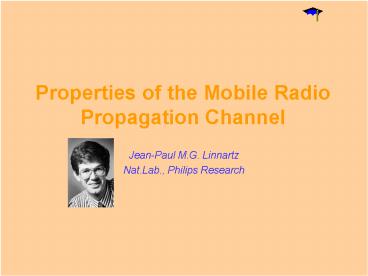Properties of the Mobile Radio Propagation Channel - PowerPoint PPT Presentation
1 / 37
Title:
Properties of the Mobile Radio Propagation Channel
Description:
Time dispersion poses requirements on synchronization and rate of convergence of ... The Doppler spectrum has a characteristic U-shape. ... – PowerPoint PPT presentation
Number of Views:46
Avg rating:3.0/5.0
Title: Properties of the Mobile Radio Propagation Channel
1
Properties of the Mobile Radio Propagation Channel
- Jean-Paul M.G. Linnartz
- Nat.Lab., Philips Research
2
Statistical Description of Multipath Fading
- The basic Rayleigh / Ricean model gives the PDF
of envelope - But how fast does the signal fade?
- How wide in bandwidth are fades?
- Typical system engineering questions
- What is an appropriate packet duration, to avoid
fades? - How much ISI will occur?
- For frequency diversity, how far should one
separate carriers? - How far should one separate antennas for
diversity? - What is good a interleaving depth?
- What bit rates work well?
- Why can't I connect an ordinary modem to a
cellular phone? - The models discussed in the following sheets
- will provide insight in these issues
3
The Mobile Radio Propagation Channel
A wireless channel exhibits severe fluctuations
for small displacements of the antenna or small
carrier frequency offsets.
Amplitude
Frequency
Time
Channel Amplitude in dB versus location (
timevelocity) and frequency
4
Some buzz words about Time Dispersion and
Frequency Dispersion
Time Dispersion Frequency Dispersion
5
Fading is characterised by two distinct mechanisms
- 1. Time dispersion
- Time variations of the channel are caused by
motion of the antenna - Channel changes every half a wavelength
- Moving antenna gives Doppler spread
- Fast fading requires short packet durations, thus
high bit rates - Time dispersion poses requirements on
synchronization and rate of convergence of
channel estimation - Interleaving may help to avoid burst errors
- 2. Frequency dispersion
- Delayed reflections cause intersymbol
interference - Channel Equalization may be needed.
- Frequency selective fading
- Multipath delay spreads require long symbol times
- Frequency diversity or spread spectrum may help
6
Time dispersion of narrowband signal (single
frequency)
Transmit cos(2p fc t) Receive I(t) cos(2p fc
t) Q(t) sin(2p fc t) R(t) cos(2p fc t f)
- I-Q phase trajectory
- As a function of time, I(t) and Q(t) follow a
random trajectory through the complex plane - Intuitive conclusion
- Deep amplitude fades coincide with large phase
rotations
7
Doppler shift
- All reflected waves arrive from a different
angle - All waves have a different Doppler shift
The Doppler shift of a particular wave is
Maximum Doppler shift fD fc v / c
- Joint Signal Model
- Infinite number of waves
- Uniform distribution of angle of arrival f
fF(f) 1/2p - First find distribution of angle of arrival the
compute distribution of Doppler shifts - Line spectrum goes into continuous spectrum
8
Doppler Spectrum
If one transmits a sinusoid, what are the
frequency components in the received signal?
- Power density spectrum versus received frequency
- Probability density of Doppler shift versus
received frequency - The Doppler spectrum has a characteristic
U-shape. - Note the similarity with sampling a
randomly-phased sinusoid - No components fall outside interval fc- fD,
fc fD - Components of fD or -fD appear relatively
often - Fades are not entirely memory-less
9
Autocorrelation of the signal
We now know the Doppler spectrum. But how fast
does the channel change?
- Wiener-Kinchine Theorem
- Power density spectrum of a random signal is the
Fourier Transform of its autocorrelation - Inverse Fourier Transform of Doppler spectrum
gives autocorrelation of I(t) and Q(t)
10
Autocovariance of amplitude
11
How to handle fast multipath fading?
12
Frequency Dispersion
- Frequency dispersion is caused by the delay
spread of the channel - Frequency dispersion has no relation to the
velocity of the antenna
13
Frequency Dispersion Delay Profile
14
Typical Delay Spreads
15
Channel Parameters at 1800 MHz
- Environment Delay Spread Angle spread Max.
Doppler shift - Macrocellular Rural flat 0.5 ms 1 degree 200
Hz - Macrocellular Urban 5 ms 20 degrees 120 Hz
- Macrocellular Hilly 20 ms 30 degrees 200 Hz
- Microcellular Factory, Mall 0.3 ms 120
degrees 10 Hz - Microcellular Indoors, Office 0.1 ms 360
degrees 2..6 Hz
16
Typical Delay Profiles
17
How do systems handle delay spreads?
18
Frequency and Time Dispersion
19
Scatter Function of a Multipath Mobile Channel
Gives power as function of
f
Doppler Shift (derived from angle )
Excess Delay
Example of a scatter plot
Horizontal axes
x-axis
Excess delay time
y-axis
Doppler shift
Vertical axis
z-axis
received power
20
Scatter Function of a Multipath Mobile Channel
Example of a scatter plot
Excess Delay
Doppler Shift derived from angle f
21
Correlation of Fading vs. Frequency Separation
22
(No Transcript)
23
Coherence Bandwidth
24
Effects of fading on modulated radio signals
25
Effects of Multipath (I)
26
Effects of Multipath (II)
27
Time Dispersion Revisited
- The duration of fades and
- the optimum packet length
28
Time Dispersion Revisited Duration of Fades
29
Two-State Model
30
Average Fade / Nonfade Duration
31
Level Crossings per Second
32
Average nonfade duration
33
How to handle long fades when the user is
stationary?
34
Optimal Packet length
35
Optimal Packet length
fc 900 MHz 72 km/h (v20 m/s) fade margin 10 dB
36
Derivation of Optimal Packet length
37
Average fade duration
38
Conclusion
- The multipath channel is characterized by two
effects - Time and Frequency Dispersion
- Time Dispersion effects are proportional to speed
and carrier frequency - System designer needs to anticipate for channel
anomalies































